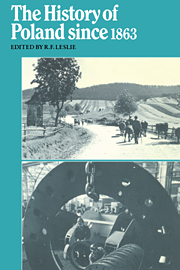Book contents
- Frontmatter
- Contents
- List of maps
- Preface to the paperback edition
- Abbreviations
- Map 1 Poland in the nineteenth century
- 1 Triloyalism and the national revival
- 2 Poland and the crisis of 1900–7
- 3 Poland on the eve of the First World War
- 4 The emergence of an independent Polish state
- 5 The breakdown of parliamentary government
- 6 Piłsudski in power, 1926–35
- 7 Poland without Piłsudski
- 8 Poland in defeat, September 1939–July 1941
- 9 The ill-fated alliance, August 1941–April 1943
- 10 The years of Tempest, May 1943–December 1944
- 11 Post-war Poland
- 12 The rise and ebb of stalinism
- 13 The October turning point
- 14 ‘The little stabilization’
- 15 The decline of Gomułka
- 16 Poland under Gierek
- 17 Polish society, 1945–75
- Epilogue: The rise and fall of Solidarity
- Notes
- Select bibliography
- Index
5 - The breakdown of parliamentary government
Published online by Cambridge University Press: 26 December 2009
- Frontmatter
- Contents
- List of maps
- Preface to the paperback edition
- Abbreviations
- Map 1 Poland in the nineteenth century
- 1 Triloyalism and the national revival
- 2 Poland and the crisis of 1900–7
- 3 Poland on the eve of the First World War
- 4 The emergence of an independent Polish state
- 5 The breakdown of parliamentary government
- 6 Piłsudski in power, 1926–35
- 7 Poland without Piłsudski
- 8 Poland in defeat, September 1939–July 1941
- 9 The ill-fated alliance, August 1941–April 1943
- 10 The years of Tempest, May 1943–December 1944
- 11 Post-war Poland
- 12 The rise and ebb of stalinism
- 13 The October turning point
- 14 ‘The little stabilization’
- 15 The decline of Gomułka
- 16 Poland under Gierek
- 17 Polish society, 1945–75
- Epilogue: The rise and fall of Solidarity
- Notes
- Select bibliography
- Index
Summary
The new Poland
After over a hundred years of foreign rule the dream of independence had been achieved, but it was no easy task to unite areas which had for so long been integral parts of Russia, Austria–Hungary and Germany, and whose social and economic development had as a result diverged enormously. Thus the mines, textile industry and metallurgical works of the Kingdom of Poland were dependent upon the Russian market, while Upper Silesia's coal mines, iron and zinc foundries and chemical industry had been linked with Germany. The efficient capitalist agricultural system of Poznania and Pomerania had supplied food to the large German towns. It is estimated that of products exported from partitioned Poland 83.3 per cent had gone to the partitioning powers, while 85 per cent of imports came from them. After 1918 this association ceased. The Russian market was virtually closed, while the high tariffs of Poland and the Habsburg successor states hampered trade. Some industries like sugar refining duplicated one another in the different parts of Poland, while others, such as machine tools and armament industries, were almost entirely lacking. The level of agricultural development varied widely from the highly productive farms of the former Prussian areas to the backward estates of the eastern borderlands and the dwarf holdings of Galicia, where in 1921 four-fifths of all farms were less than 5 hectares.
The creation of a single economic system was a slow and difficult process. It was only in 1920 that a single currency was established. Until then as many as six currencies had circulated in the country.
- Type
- Chapter
- Information
- The History of Poland Since 1863 , pp. 139 - 158Publisher: Cambridge University PressPrint publication year: 1980



